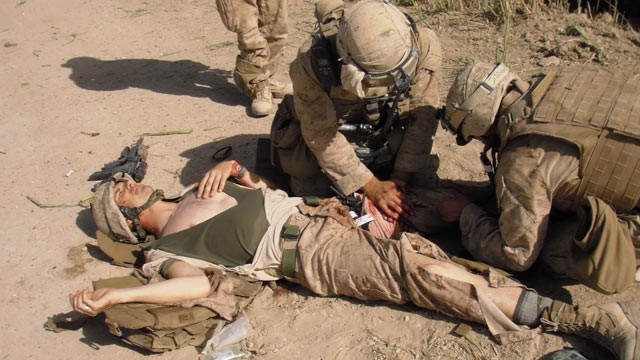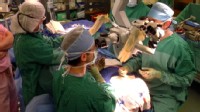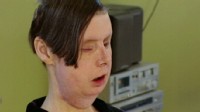
Ron Strang lay helpless in the dirt as the hole in his leg was packed with gauze and swathed in bandages.
September 13, 2012
The Marine sergeant was on foot patrol in Afghanistan's Helmand Province when an improvised explosive device tore through his left thigh, shredding his muscle and draining half his blood.
"I'm sure I would've died without the quick actions of my fellow Marines," said Strang, 28, who endured more than a dozen surgeries and painful skin grafts to close the gaping wound.
Though his skin eventually healed, Strang was left with half the quadriceps he once had.
"I had to use a cane or walker," he said, adding that he would fall "a couple times a week."
But an experimental treatment has tricked his body into regenerating itself, and now Strang can walk -- even run -- without help.
"I had no clue this even existed," he said of the pioneering procedure to implant pig tissue stripped of cells deep inside his thigh. "I was skeptical at first, but it was amazing to learn how it works."
Man Gets Full Face TransplantWatch Video
Chimp Attack Victim's Amazing Recovery Watch Video
Farmer Receives Two New Arms Watch Video
The tissue, called extracellular matrix, acted as a cell-scavenging scaffold, recruiting Strang's own stem cells to rebuild his muscle from the inside out.
"It's a game changer," said Stephen Badylak, deputy director of the University of Pittsburgh Medical Center's McGowan Institute for Regenerative Medicine. "It's definitely more effective than anything that's been tried to date."
Strang's surgery is just one example of cutting-edge science aimed at making wounded vets whole again.
"We're basically pushing the envelope of regenerative and restorative medicine at a much faster rate than ever," said Col. John Scherer, director of the U.S. Army Medical Department's Clinical and Rehabilitative Medicine Research Program in Fort Detrick, Md. "We see it as a critical component of providing improved care for wounded service members."
Scherer oversees the Armed Forces Institute of Regenerative Medicine, or AFIRM, a program launched in 2008 to translate innovative laboratory research into treatments for troops with once-fatal injuries.
"We're saving a lot of people that would have died from their wounds 10 years ago," said Scherer, adding that advances in body armor and battle field care are helping more soldiers survive the wounds of war. "Now we're faced with these very large, catastrophic injuries to the limbs, the head and neck that we've not seen before because they just weren't survivable."

Marine Sgt. Ron Strang can walk after an experimental procedure to rebuild his thigh muscle. (Courtesy Ron Strang)
In its four years, AFIRM has funded eight clinical trials, with several more on the horizon.
Veterans are eager to enroll, Scherer said.
"I think most of them say, 'If I can help my buddies, I'm willing to step up and participate in the trials,'" he said.
Cutting Edge Treatments Heal Wounds of War
While AFIRM pushes the limits of regenerative medicine, other programs like Operation Mend, which helps burned and disfigured service members get ground-breaking reconstructive surgery, aim to improve veterans' access to cutting-edge care.
"We've had 86 patients come through the program, with over 250 operations," said Dr. Christopher Crisera, associate professor of plastic and reconstructive surgery at Ronald Reagan UCLA Medical Center and medical co-director of Operation Mend.
Mike Mills was one such service member. The Army staff sergeant suffered third-degree burns to almost a third of his body when an IED detonated next to his vehicle in Iraq.
"I was missing half my left ear, and my nose was pretty much gone," said Mills, 47, who also lost two fingers and shattered multiple bones. "I was content with how I looked without the nose. But I don't like people staring at me, so I was becoming a bit withdrawn."
Through Operation Mend, Mills had surgery to reconstruct his nose using tissue from his forehead.
"Now that I have the nose, I don't get as many stares," said Mills, adding that he would never have been able to afford the surgery without Operation Mend's help.
"It's normal when you're burned or disfigured to be self-conscious," said Crisera, explaining how "form and function" go hand in hand. "If you can restore some normalcy to the form, you can restore their self-confidence. That's one of the most gratifying things about the program."
Mills still gets some stares because of his ear. But researchers at Massachusetts General Hospital may one day fix that, too. They've created a living ear replica by seeding sheep cartilage cells on an ear-shaped scaffold.
"The scaffold is special because it's made of collagen, which is the component of your skin that makes it stretchy, and a metal framework that helps maintain the shape," said Cathryn Sundback, co-director of the Boston-based hospital's Laboratory for Tissue Engineering and Organ Fabrication.
The stand-in thrived when it was implanted onto sheep. The next step will be clinical trials that would use patients own cartilage cells, borrowed from the septum of the nose or the ribs, to grow replacement ears.
"I'd like to think we're going to make a big difference, particularly in the area of recreating injured war fighters' faces," said Sundback.

Army Staff Sgt. Michael Mills, pictured with his wife, Suhanna, and musician Ted Nugent, had his face rebuilt after an IED blast in Iraq. (Courtesy Mike Mills)
For Strang and Mills, the science that's helping them and their fellow service members rebuild their broken bodies sounds more like science fiction.
"It's really amazing that you can take stuff and make bones and muscle, grow ears and organs," said Strang, adding that he's glad scientists have his back. "It definitely makes me happy that they're looking out for us in that way. And they're just getting started. There's so much more they can do."



No comments:
Post a Comment